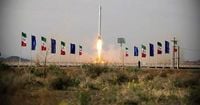Iran’s ambitions in space have taken a bold step forward, as the Iranian Space Agency (ISA) unveiled plans to begin test launches for its first narrowband satellite constellation, named after the late Qassem Soleimani, before the end of 2025. The Martyr Soleimani constellation, as it is officially titled, marks a significant milestone in Iran’s quest to expand its technological footprint and reduce dependence on foreign space infrastructure. According to BORNA and the Tasnim news agency, this initiative is not just about national pride—it’s a calculated effort to position Iran at the forefront of regional satellite communications and the rapidly growing Internet of Things (IoT) sector.
Hassan Salarieh, head of the Iranian Space Agency, has been the public face of the project, providing details that shed light on the country’s methodical approach. “The design phase of the constellation began in the second half of 2023, and most of the subsystems are now under construction,” Salarieh explained, according to BORNA. The project, he said, is being carried out by a consortium of private and state entities—a sign of Iran’s intent to blend governmental oversight with private-sector innovation.
The Soleimani constellation is set to consist of nearly 20 satellites, all built domestically using Iranian expertise. These satellites will be deployed in orbits with varying inclinations, designed to provide narrowband communications across the country. The goal? To lay the groundwork for robust IoT services, enabling everything from smarter agriculture to more efficient urban infrastructure. “In the initial phase, nearly 20 satellites will be built and placed in orbits with different inclinations to provide narrowband communications aimed at developing Internet of Things services,” Salarieh told the Tasnim news agency.
Trial launches of prototype satellites are scheduled for 2025, with some of these prototypes expected to reach orbit for initial testing and system checks. If all goes according to plan, the main production phase will kick off in 2025 as well, with operational launches of the full constellation expected to begin in late 2025 and continue into 2026. However, Salarieh was candid about the challenges ahead, acknowledging that “technical challenges and delays are natural in the space industry,” but adding that progress so far was “satisfactory.”
The constellation’s name is a deliberate nod to Qassem Soleimani, the former commander of Iran’s Quds Force who was killed in a U.S. drone strike in Baghdad in 2020. This symbolic naming underscores the political and strategic dimensions of the project, placing it at the intersection of national memory and technological aspiration.
Iran’s recent space activities have not gone unnoticed. The announcement of the Soleimani constellation comes on the heels of Iran’s successful launch of the Nahid-2 telecommunications satellite aboard a Russian Soyuz rocket from the Vostochny Cosmodrome. Salarieh has since revealed that a second version of Nahid-2 will be launched using Iran’s own Simorgh rocket—a clear signal that Tehran is intent on developing independent launch capabilities and reducing reliance on foreign partners. The push for autonomy doesn’t stop there: Iran is actively developing heavier launch vehicles, including the Sarir and Soroush classes, and is expanding its Chabahar spaceport on the Gulf of Oman.
“Iran is also developing heavier launchers, including the Sarir and Soroush classes, and is expanding its Chabahar spaceport to reduce reliance on foreign facilities,” reported the Tasnim news agency. This expansion is part of a larger strategy to establish a sustainable, homegrown space program that can support not only communications satellites but also, potentially, earth observation and scientific missions in the future.
Meanwhile, the Islamic Revolutionary Guard Corps (IRGC) has been conducting its own space activities. In July 2025—just weeks after the brief but intense 12-day war with Israel—the IRGC carried out suborbital tests of its Qased satellite carrier. These developments have drawn the attention of Western governments, who have repeatedly voiced concerns that Iran’s satellite launch technology could be repurposed for ballistic missile development. The overlap between civilian and military rocket technology is a longstanding source of tension, with critics arguing that satellite launches can serve as a cover for advancing missile capabilities. Tehran, for its part, maintains that its space program is strictly peaceful and aimed at technological progress and economic development.
The Martyr Soleimani constellation is not just about technological prowess; it’s also about economic opportunity. By building a network of satellites dedicated to narrowband communications, Iran aims to unlock the potential of IoT—a sector that is reshaping industries worldwide. Narrowband IoT satellites can connect sensors and devices in remote or underserved regions, paving the way for smarter water management, logistics, transportation, and more. For a country as geographically diverse as Iran, with vast deserts, mountains, and rural areas, such connectivity could be transformative.
Of course, the path to orbit is rarely smooth. Salarieh has cautioned that delays are to be expected, given the inherent complexity and risk of space projects. “Delays are possible due to the technical challenges of space projects, which he described as ‘natural in this industry,’” BORNA reported. Yet, the ISA chief remains upbeat about the overall pace of progress, confident that Iran’s first domestically developed satellite constellation will soon be a reality.
The project’s collaborative structure is another noteworthy aspect. By involving both government and private sector partners, Iran is signaling a willingness to harness the strengths of both spheres—governmental stability and resources, private sector agility and innovation. This approach mirrors global trends in space exploration, where public-private partnerships have become the norm rather than the exception.
As the countdown to the first test launches continues, international observers will be watching closely. The stakes are high—not just for Iran, but for the geopolitical landscape of space in the Middle East. The successful deployment of the Soleimani constellation could set a precedent for other regional powers, potentially triggering a new era of space competition (and, perhaps, cooperation) in a part of the world more often associated with terrestrial conflicts than orbital ambitions.
For now, the Iranian Space Agency is focused on the technical hurdles ahead. Salarieh and his team are racing against the clock to complete subsystem construction, integrate the satellites, and prepare for the all-important test launches in 2025. The world will be watching to see if Iran can deliver on its promises—and what the ripple effects might be for technology, politics, and security in the region.
As Iran’s space program gathers momentum, one thing is clear: the race for the final frontier is no longer the exclusive domain of superpowers. With the Martyr Soleimani constellation, Iran is staking its claim among the world’s spacefaring nations—determined, ambitious, and undeterred by the gravity of the challenges ahead.




